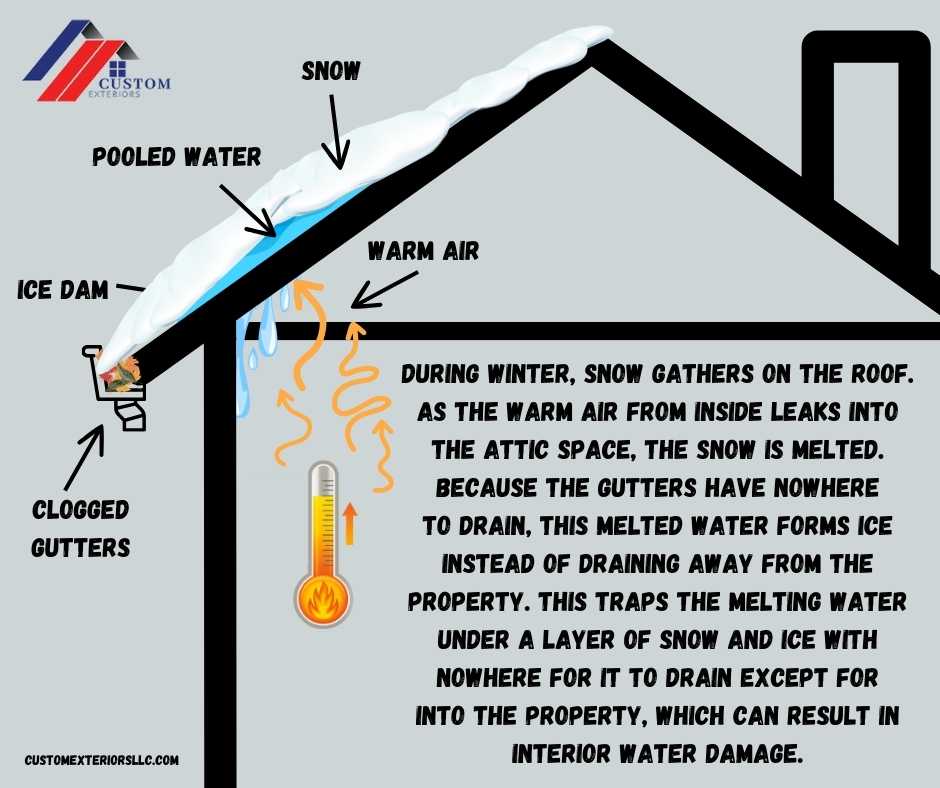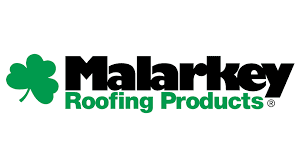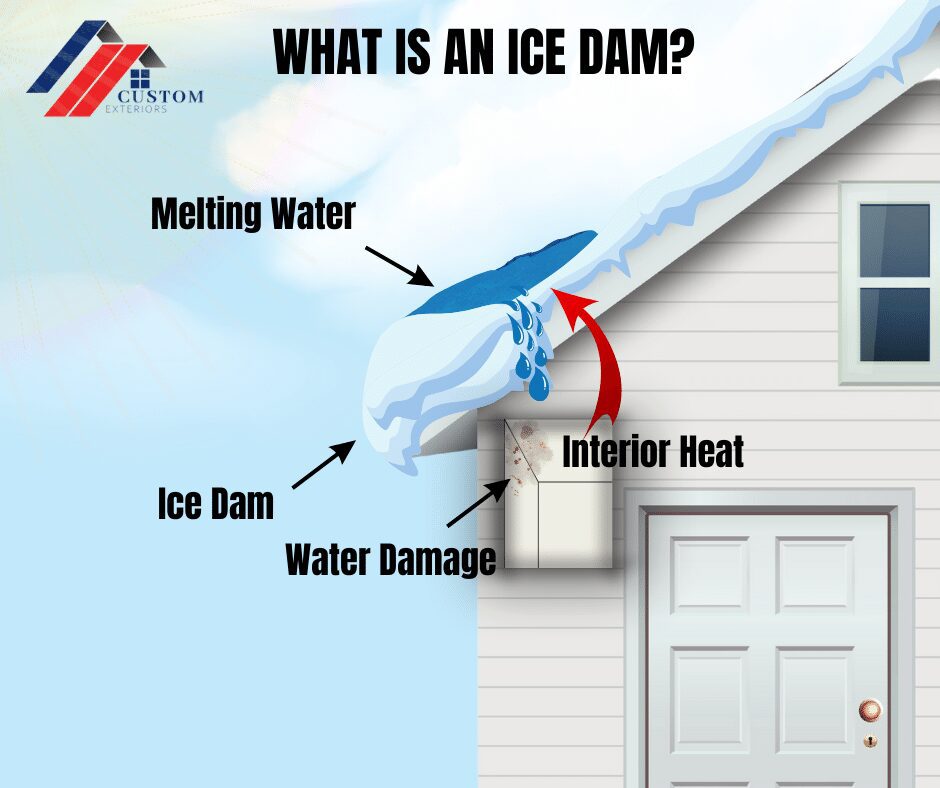Understanding ice dams on roofs:
What they are and how to prevent them
As a seasoned roofing contractor based in Colorado, we have inspected, replaced, and repaired countless roofs, identifying a wide array of issues. However, one frequent and often misunderstood culprit behind a leaky roof is not what you’d typically suspect—it’s ice dams, often caused by poorly maintained and clogged gutters or inadequate roof venting.
In Colorado, ice dams are a common wintertime roofing issue. Picture a cold winter day, your property cozily heated from inside. As the warmth of the interior rises, it meets the cold underside of the roof. The melting snow from the warmer parts of your roof flows down and refreezes at the colder edge, particularly if your gutters are clogged and not allowing for proper drainage. This cycle creates an actual dam of ice, further preventing proper drainage and potentially causing water to back up under your shingles and into your home.
Understanding what an ice dam is and recognizing the role of gutter system maintenance is crucial in preventing it. Factors that play a role in ice dams forming are:
- Clogged Gutters
- Improper Roof Ventilation
- Inconsistant Roof Temperatures
- Complex Roof Designs
- Lack of Snow Removal
What is an Ice Dam? A closer Look
An ice dam, quite simply, is a ridge of ice that forms at the edge of a roof. When the snow on your roof melts due to heat escaping from your home or from the sun’s rays, water trickles down towards the edge. Now, the house’s eaves (the part of the roof that overhangs at the bottom) are usually colder because they’re beyond your home’s insulation. So, when that melted snow reaches the colder eaves, it refreezes, creating this ridge or “dam” of ice.
Why is this a problem? As more snow melts and trickles down, it hits this dam and has nowhere to go. Instead of harmlessly dripping off your roof or flowing into the gutters, the ice dam traps the water. Over time, this backed-up water can seep under the roof shingles. This can potentially lead to leaks inside your house. Ice dams can cause damage without making their presence overly noticeable.

So, while those hanging icicles might look pretty, they can sometimes signify a more significant issue. Ice dams can be the culprit behind water damage in many homes during the winter months. The first step in tackling this winter challenge is being informed about what they are and how they form.
What causes ice dams?
In the heart of winter, when icicles elegantly drape from the edge of your gutter, an unexpected process can take place on your roof. Ice damming. But what are the root causes of ice dams?
Firstly, consider the warmth of your home during the cold months. This heat tends to rise, meeting the underside of the roof. When it does, it can prompt the snow directly above to melt, even if the outside temperature seems bitterly cold.
Interestingly, the temperature is not uniform across the entirety of your roof. The higher sections, mainly those closer to the peak, are generally warmer due to the upward-moving heat from the house’s interiors. On the flip side, the roof’s eaves or overhanging parts are often colder. They stretch beyond the home’s main structure and are not influenced by indoor heating. So, as the melted snow from the warmer parts travels down the roof’s slope, it encounters the colder eaves. Here, it refreezes, layer by layer, leading to the ice dam’s creation.
This same effect can be caused when your gutter system is clogged and does not allow for adequate water drainage. Without a way to drain away from your property, this melted snow will refreeze in place, creating an ice dam at the edge of your roof. This causes the formation of ice dams, which can easily be prevented with some routine exterior maintenance.
Lastly, ice dams can also form due to inadequate insulation and venting in your attic space. These can cause more heat to escape the roof, increasing the snow melt. As this melt reaches the cooler section of the roof, it can refreeze, causing an ice dam to build.

Do Ice dams cause damage?
When you think of a dam, you might imagine it holding back a large body of water. Similarly, an ice dam holds back melting snow. But unlike the dams we are familiar with, roofs are not designed to hold water. As the ice dam grows, it creates a pool of water behind it. This standing water is the first point of concern. As mentioned, roofs are designed to shed water, not let it stand. The longer water remains pooled, the more time it has to find a way inside. It can start to seep under shingles, trickle down the roof decking, and, ultimately, penetrate the home’s interior. This can lead to a series of issues:
-
1. Leaky Roof And Ceilings:
The most immediate effect of water infiltration is a leaky roof. Water might begin to drip inside. This can stain the ceiling and even lead to structural damage over time.
-
2. Compromised Insulation:
Once the water passes the roof and into the attic, it can saturate insulation. Wet insulation loses its effectiveness, meaning your home becomes less energy-efficient. This can lead to higher heating bills in the winter and cooling bills in the summer.
-
3. Mold And Mildew:
Damp environments are breeding grounds for mold and mildew. These can damage the home's structure and pose health risks, especially for those with respiratory conditions or allergies.
-
4. Gutter Damage:
The weight of ice dams can strain gutters and downspouts. Over time, this can lead to them pulling away from the house or becoming damaged. This can affect their ability to channel water away from the foundation.
-
5. Water Damage:
Beyond the structural issues, there's the unsightly damage. Water stains, peeling paint, and damaged drywall can impact the appearance of your home's interior.
Understanding the potential damage ice dams can cause is the first step toward proactive prevention. Recognizing the potential damage and costly repairs that can be caused by ice dams allows homeowners to take preventative action. In doing so, they are ensuring their homes remain safe and damage-free during the icy grips of winter.
Preventing ice dams: pro tips for a damage-free winter
You now know the hidden hazards of ice dams, so naturally, the next question is: how can you prevent them? Prevention is always better (and usually cheaper) than the cure, especially regarding home maintenance. So, let’s jump into some expert-backed strategies to prevent ice dams from damaging your home. Keys to controlling ice dams include:
- Remove snow from the roof
- Complete regular gutter system maintenance
- Install heat cables along the eaves of the roof
- Ensure proper roof ventilation
- Reduce interior air leakage
Preventative measures to prevent ice dams
It’s important to remember that one of the main issues that cause ice dams is the heat escaping from your home and melting the snow on your roof. By boosting the insulation in your attic, you can ensure the heat stays where it belongs – inside your home and not warming the roof. Ideally, aim for an insulation value (or R-value) that’s recommended for your specific region. Energy Star breaks down recommended R-values for areas throughout the United States.
Another consideration is to improve your attic ventilation. A well-ventilated attic helps maintain a cooler roof. In doing so, it reduces the chances of snow melting and refreezing. A great option to increase ventilation is to consider adding ridge and soffit vents. These will create a natural flow of cold air, keeping the entire roof at a consistent temperature. A reputable roofing contractor can properly calculate the appropriate number of roof vents your system needs.
Lastly, property owners have seen success in preventing ice dams by installing heat cables along the eaves of their homes. Consider installing heat cables in a zigzag pattern on your roof and in your gutters for particularly troublesome areas. When activated, they create channels for the melted snow to flow off the roof, preventing the formation of ice dams. We find this strategy to be particularly beneficial in areas like the Colorado mountains, where there is the potential for heavy snowfalls and outside temperatures that prevent the snow from quickly melting.
Maintenance measures that help prevent ice dams
After a heavy snowfall, consider using a roof rake with a long handle to clear the snow off the edges of your roof. This reduces the amount of snow available to allow ice dams to form. However, remember always to exercise caution and safety when doing this. Heavy snow and heights may make this project out of reach for some due to physical limitations.
Another area that can help prevent ice dams is sealing air leaks in your home. Little gaps and cracks in your home might seem harmless, but they allow warm air to escape, contributing to the snow melting on your roof. So, check around electrical cables, exhaust vents, and places where walls meet the ceiling. Sealing these gaps can be a game changer.
Additionally, it is essential to ensure your gutters are free of leaves, twigs, and other debris. Clear gutters help melted snow flow off your roof efficiently and prevent it from refreezing. Gutters should be cleaned in the shoulder seasons before the harshest weather months.
Lastly, whether it is due to physical or time limitations, sometimes it’s just best to consult a professional roofer. If you’ve had recurrent issues with ice dams, are uncertain about your home’s preparedness, or cannot complete the tasks above, consider getting a home energy audit. Professionals can provide tailored advice and solutions specific to your home’s needs.
avoid Winter challenges to your roof
Winter, with snowfall and cozy moments, can be a magical season. But as with all things, it comes with its own set of challenges – ice dams being a prime example. At Custom Exteriors, we believe that knowledge is power. So, by understanding what causes ice dams, recognizing their potential for damage, and arming yourself with proven preventative strategies, you’re setting the stage for a damage-free winter. Remember that our homes require care and preparation to weather the colder months.
If you ever find yourself unsure or overwhelmed, don’t hesitate to seek professional advice. In the age of information, resources are generally just a click away. Many exterior companies provide regular maintenance plans to assist with the tasks required to keep a healthy roof system. So, stay informed, stay prepared, and enjoy a peaceful home this winter. As always, if you have questions, we’re here to help you make the most of every season. Safe and sound.
Contact Us Today
We Service and Support the Following Brands










Contact
Custom Exteriors, LLC
18674 Co Rd 3, Berthoud, CO 80513
109 E. 17th St. Ste 5822, Cheyenne, WY 82001
102 S. Tejon St. Ste 1100, Colorado Springs, CO 80903
404 Broadway, Eagle CO 81631
Phone: 970-460-8714
Toll Free: 800-580-0131
Quick Links
© 2022 Custom Exteriors, LLC



